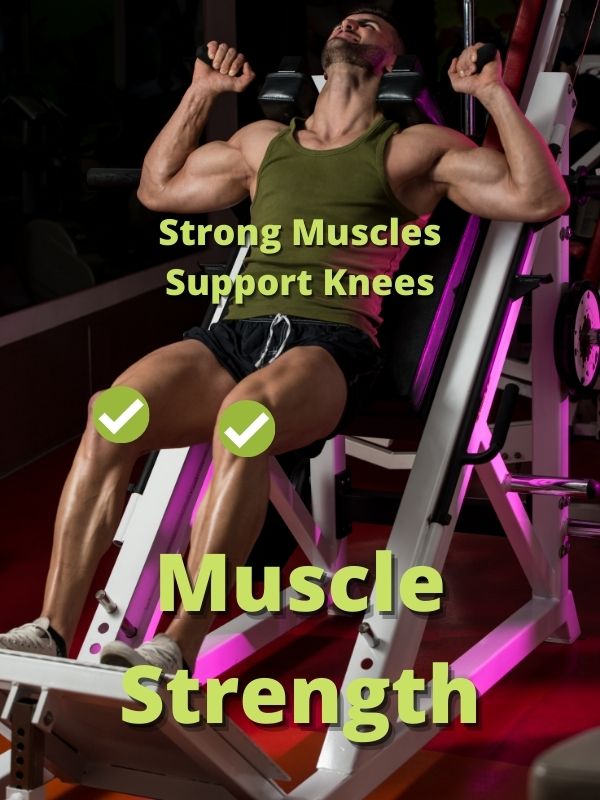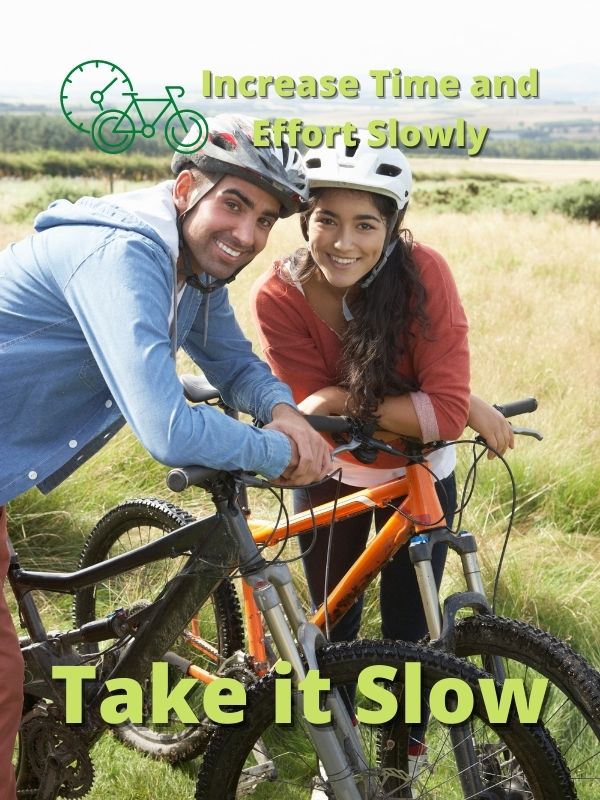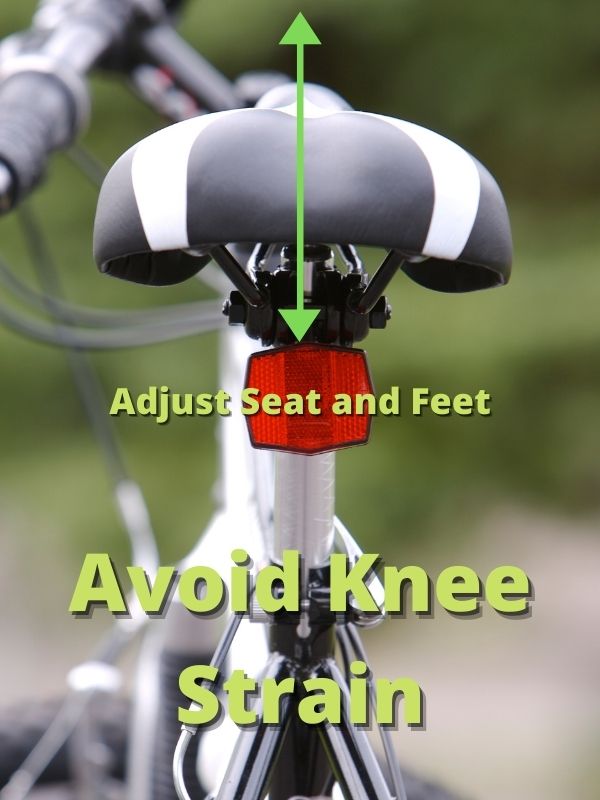If you are someone who cannot stay away from biking even if you have knee pain or injury, then it’s always smart to first consult your doctor. Ask about your current limits of knee pain and ride within those limits. Your physical therapist or doctor is the one who can determine if biking is safe for you or not.
In this article, I will discuss 5 tips that may help you ride a bike if you have knee pain and give you the most benefit without aggravating your knee pain. These tips are:
- Give Knees Time To Heal
- Increase Muscle Strength
- Increase Cycling Time and Effort Slowly
- Stretching
- Check Seat Height And Foot Position
Once you get a green signal from your doctor, you can start applying the mentioned tips. After some time of healing, I remember my physical therapist telling me to start exercising but not with weights and not if it hurts.
1. Give Knees Time To Heal

If you have injured your knee or have slight knee pain and still want to ride a bike, the best thing you could do is take a rest and give it time to heal. It is important to have complete rest and take a hiatus from walking, working, biking, and exercises. Your body heals itself, but everything does take a little time. If you do not give it proper time, the pain might get worsen.
But that doesn’t mean to lounge on the couch for days. Instead, stay active since movement is the medicine for healing the body. So I would recommend you look for a pain-free exercise such as a light warm-up or simple yoga poses. You can also do a shorter cycle but make sure you feel no pain to little pain during or after biking.
However, if you still feel nervous about returning to biking, focus on increasing muscle strength, which is my next tip to help you ride a bike if you have knee pain.
2. Increase Muscle Strength

You must be worried that working out may cause more knee pain or damage, but if your doctor says it is OK, then you should definitely go for it. You can see my article about strengthening your knees or try some of the exercises below.
If your knees are healthy weights would be fine, but if they hurt try exercises without weights. The next tip I would give you is to strengthen the muscles that support your knees and make them flexible. Here are a few workouts that I would suggest to strengthen your muscles and help you ride a bike with knee pain.
- Straight Leg Raises
If you are having knee pain, start with simple strengthening exercises like leg raises. This exercise puts little to no strain on your knees. Lie on the floor or a flat surface, bend one knee while placing the foot flat on the surface. Keep the other leg straight, start raising it to the height of the bent knee. Repeat this process for 10 to 15 minutes.
- Prone Straight Leg Raises
For this workout, lie on your stomach and keeping legs straight. Tighten your bottom’s muscles of one leg, and rise toward the ceiling. Hold it for 3 to 5 seconds, lower, and repeat. Repeat for 10-15 lifts and switch legs. You can also add ankle weights once you gain some strength. You shouldn’t feel any pain, but if you do, consult your doctor.
- Hamstring Curls
This is an amazing workout to strengthen your muscles so you can ride a bike even with knee pain. Lie flat on your stomach. Gradually bring your heels closer to your butt as much as possible and hold that position.
Do it 15 times for three sets. You can also do it while standing. Hold onto a chair and lifting one leg at a time. When this becomes easy for you, try adding ankle weights and slowly add to the weight from 1-3-5 pounds.
- Calf Raises
Stand facing the back of a couch, a sturdy chair, or a wall bar. Gradually raise your heels as high as you can and then lower down. Do 10 to 15 times for three sets. When it becomes easier for you, try to lift one foot off the floor and putting all your weight on the other foot.
- Step-Ups
Place your one foot on a platform, on a step bench, or the lowest steps of the staircase. Bend your knee to the pelvis level and slightly lower the opposite foot to the floor. Touch your toe to the floor, and lift back up. Repeat the process 10 to 15 times, then switch legs.
- Side Leg Raises
Lie on one side on the floor with your legs stacked. You can bend the bottom leg if you need support. Straighten your top leg, raise it to 45 degrees, and hold it in this position for 5 seconds. Lower your leg, relax, and repeat. Do it 10 to 15 times and then switch sides.
- Wall Squats
Wall squats are a more advanced move. For this, keep your feet on the floor about shoulder-width apart while standing with your back against the wall. Gradually bend your knees and keeping the back against the wall. Hold this position for 5 to 10 seconds. Do not bend too deep. Also, if you feel any pain or discomfort in your knees, change your position accordingly. Repeat the process.
3. Increase Cycling Time and Effort Slowly

Your first bike ride after an injury or knee pain shouldn’t be too long. A rapid increase in training, biking, or cycling time can abruptly increase your knee pain. Therefore my next tip for you would be to increase cycling time and effort slowly.
You need to gradually increase your biking time and effort as your muscles, ligaments, and tendons get stronger. Do not put too much force as it may result in a prolonged injury.
Begin with a short ride. I would suggest you start with a 5 to 10 minutes ride at a low resistance. Go easy initially; after that, slowly increase the intensity and length of your ride with progress. Work your way up to 140 to 150 minutes with moderate intensity biking per week.
This would make you bike for 30 minutes, five times a week. You can also try splitting the time into 10-minutes blocks if that’s possible for your joints. To see if you have moderate-intensity biking, you should be able to converse while biking with an increased breathing rate.
4. Stretching

Stretch every day is a pro tip if you have knee pain and still want to ride. You need to stay active. Here is some simple stretching that may diminish your knee pain, and you will start biking.
Stretching provides the flexibility and movement needed to avoid further injury. If you have tight muscles, consider warming up thoroughly and stretching before going on any vigorous ride.
- Quadricep Stretch
For quadriceps stretch, put one hand on the wall or hold on the back of a chair for balance and support. Lift one foot behind your body and grasp the ankle with your hand. Keep your knees close together and the back straight.
Try to pull the heel closer to the buttocks as much as you can without causing pain or force. Hold it for 30 seconds and lower the leg slowly. Switch sides and repeat the process.
- Toe Touches
Stand with the feet close together. Gradually bend over and pull out the arms downward. Keep your legs straight but avoid locking the knees. Try to reach your fingers to the top of the toes as much as possible. Hold it for 30 seconds.
Hold your body still, and avoid using bouncing motions. At first, your fingers may not reach the toes, but you can try to get them as close as possible without forcing and causing pain.
- Standing Hamstring Stretch
Stand up straight with feet shoulder-width apart. Slightly bend at the hips and extend your right leg out a few inches in front of your body. Slightly bend the left leg while keeping your back straight.
Gradually bring your chest downward as far as possible. Hold there for 30 seconds. Slowly bring back your right leg toward the body and stand up. Repeat the process with the other leg.
5. Check Seat Height And Foot Position

If you want to ride a bike with knee pain, you should pay attention to your seat height, foot position, and the appropriate crank length. I would recommend seeking a professional bike-fit specialist, and getting advice is a better option.
These small changes can make a big difference. Also, try to be consistent with your shoes and how you place your feet on the pedal because it can improve healthy joint movement. (See Foot Placement Article)
In my opinion, it is better to make adjustments in small increases and try keeping notes of any changes that lower or raise your knee pain symptoms. I would recommend using a pair of cycling-specific orthotics.
They have a semi-custom fit that increases comfort, improves efficiency, and reduces knee pain. Do not forget to change the footbed or insole as you change your shoes. Add shoe wedges with the insole if needed.
Most of the cycling shoes stop your foot’s natural tilt and force it flat that ultimately generates knee pain. So, shoe wedges (AD) will provide you 1.5 degrees of inward angle to help with better joint alignment.
Although, it might be better to go without clip-in cycling shoes if you’ve had knee problems so you can adjust your foot position naturally.
Thanks for visiting Helpshoe.com
References
- https://www.runnersworld.com/uk/training/cross-training/a33220921/knee-pain-cycling/
- https://www.webmd.com/pain-management/knee-pain/injury-knee-pain-16/physical-therapy
- https://creakyjoints.org/diet-exercise/cycling-and-arthritis/
- https://www.medicalnewstoday.com/articles/325804
- https://mtbtime.com/cycling-knee-pain/ (Link not working)

